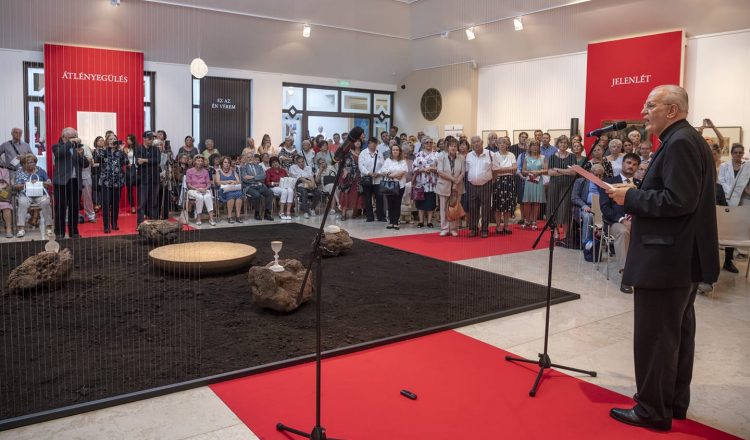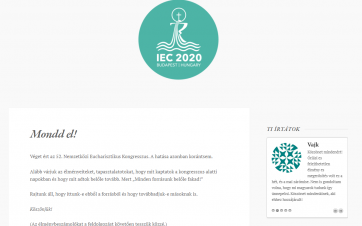Ildikó Kontsek, curation of the exhibition and director of the Christian Museum of Esztergom has explained during the opening ceremony that the historical pictures being exhibited come from the Christian Museum. These pieces of art bring back the historicism of the European Middle-Ages, the Renaissance, the Baroque, and the 19th century. The painitng of Gábor Atlasz, The Disciples of Emmaus and the big-sized installation of Norbert Bukta were made specially for the exhibition. As the curator expressed: one of the central pieces of the exhibition is the work of Ádám Kisléghi-Nagy, which was painted in the 1990's.
In his greeting words, Kornél Fábry, Secretary General of the International Eucharistic Conress in Budapest emphasised that during the history of the Church there ate more than 170 Eucharstic miracles, all of which was examined and recognised by the Vatican. The Eucharistic miracles exhibited here, along with the testimonies can help to improve our faith.
Cardinal Péter Erdő, the Archbishop of Esztergom-Budapest stressed that this exhibition draws the attention to those very special religious and societal phenomena, which appeared in Hungary around the Eucharist. He emphasised that the eucharistic feast, that is the remembrance of Christ's last supper, is the most personal, the most holy act of the Christian community. "The exhibition calls a perception beyond our senses: it leads us into the centre on the way paved with pictures, miracles and objects; into the centre where the physical existence gets elevated and opens our eyes to the reality beyond reality, to the true merit" - said the Cardinal.
During the opening on Monday, György Vashegyi, president of the Hungarian Academy of Arts called our attention that the exhibition Transubstantiation - Eucharist in the miracles and in the Arts is part of the preparatory events of the International Eucharistic Congress (IEC) being held in Budapest, in the autumn of 2020.
During the preparatory year of 2018/19 the halls of the Pesti Vigadó and the Kunsthalle will host a great number of exhibitions. In 2019 they will present the exhibition The Reverence of the Eucharist in Hungary from the Middle-Ages until today; and in 2020 the exhibit called The Remembrance of the International Eucharistic Congress of 1938 will be hosted by the Kunsthalle.
He emphasised that his event of great importance will tighten the relationship between the Academy of Arts and the Catholic Church. "The Pesti Vigadó is delighted to host the exhibition, which enables us to have an understandable and sensational glimpse into the innermost teaching of our faith through presenting the Eucharist" - said the director.
The fact that the Body and Blood of Christ is truly present in the bread and wine is shown and reinforced through the miracles all over the World Church. The central installation of the exhibition displays the arts of ancient times and the related keywords to the visitor, in order to show the mysteries of the human and divine world in a spectacular way.
In the Eucharist the characteristics of the bread and wine are kept in a specific reality. But the substance becomes something else. It becomes the Body and Blood of Christ. The word transubstantiation wishes to express this mystery, that is while the bread and wine remain sensible, "within them the whole and intact Christ is there, he is present in his corporal reality". This is a real presence, but not in sense of the everyday biological corporeality.
The exhibition call to this perception beyond the senses: it leads us into the centre on the way paved with pictures, miracles and objects; into the centre where the physical existence gets elevated and opens our eyes to the reality beyond reality, to the true merit.











